
Home - Search - Browse - Alphabetic Index: 0- 1- 2- 3- 4- 5- 6- 7- 8- 9
A- B- C- D- E- F- G- H- I- J- K- L- M- N- O- P- Q- R- S- T- U- V- W- X- Y- Z
Orion CEV
 CEV Credit: © Mark Wade |
AKA: Crew Exploration Vehicle;Orion. Status: In development 2016. Thrust: 66.60 kN (14,972 lbf). Gross mass: 23,153 kg (51,043 lb). Specific impulse: 361 s. Height: 9.84 m (32.28 ft). Diameter: 5.50 m (18.00 ft).
The Space Shuttle was sold by NASA to America in the early 1970's as a low-cost, reusable spaceship that would replace all existing boosters and manned spacecraft. The Apollo capsule and Saturn launch vehicles were scrapped. Production of all other expendable boosters would be discontinued once the Shuttle was 'fully operational'. The myth of its lower cost was maintained in the face of mounting evidence to the contrary until the shuttle Challenger exploded on the way to orbit in 1986. In the post-mortem that followed, it was discovered that the shuttle was actually more expensive and very much more operationally constraining in delivering satellites to orbit than the expendable boosters it was supposed to replace. So the American government abandoned use of the Shuttle for satellite launches and allowed production of expendable launch vehicles to resume.
But the Shuttle was now the only American manned spacecraft, so a new mission was found for it. It was claimed it was now safe after billions of dollars of post-Challenger fixes. It was also claimed that only its unique design would allow NASA to assemble a space station. The space station project stretched out, until it was taking decades. The shuttle was getting old, and America had no lifeboat - a manned re-entry vehicle - that it could use to rescue crews from the space station if the balky shuttle was unavailable. On the other hand, NASA saw development of any other manned spacecraft as a threat to the very existence of the Shuttle. Various suggested supplemental projects suggested in the 1980's and 1990's were decisively squelched. The X-38 lifting body was to be developed as a Crew Rescue Vehicle, and perhaps as a Shuttle alternative. But the initially simple skunk-works approach to the program was overwhelmed by NASA gold-plating, and it finally was quietly killed off 'due to cost over-runs'. The X-33 single-stage-to-orbit was NASA's true vision for a shuttle successor, but after spending a huge sum NASA decided SSTO was actually not attainable using existing technology, and canceled that. Given that NASA's lead-time for developing new spacecraft had gone from a few years in the 1960's to a few decades by the 1990's, NASA decided it would be prudent to start the long definition process for the Orbital Space Plane, a shuttle successor that would be launched by an expendable launch vehicle.
Then in 2003 the space shuttle Columbia was lost during re-entry. The final shuttle myth - that it was safer than alternatives - was demolished. Flights of the shuttle would have to end by 2010, it was decided, and therefore a successor ready for flight before then.
Meanwhile President Bush had been convinced by the NASA administrator O'Keefe to back yet another in-the-future grandiose manned space exploration program. The Orbital Space Plane was renamed the Crew Exploration Vehicle. Now the requirements for the spacecraft would be extended by requiring it to be the manned return vehicle not just from earth orbit, but from the moon and Mars. In the original 2003-2004 concept a CEV program would have been developed in three phases, to support NASA's then-planned three spirals of space exploration development:
- Spiral 1 systems would be available by 2014 at the latest. They would provide the hardware to replace the space shuttle in support of manned operations in low Earth orbit. NASA hoped this capability might be available as early as 2010, when the shuttle was schedule to be retired. Otherwise only the Russian Soyuz spacecraft would be available to support International Space Station operations between 2010 and the station's planned retirement in 2016. Spiral 1 systems would also allow renewed robotic exploration of the moon.
- Spiral 2 systems would allow a human landing on the moon, followed by extended duration manned lunar exploration and robotic exploration of Mars in the period 2015-2020.
- Spiral 3 systems would allow establishment of a near-permanent lunar base and continued robotic exploration of Mars. Lunar surface habitation and power systems would be developed, and the CEV would have to be capable of long-duration lunar-surface or lunar-orbit storage between crew rotations or expeditions.
In Phase 1 of the CEV program (different from Spiral 1 of the overall program!) two contractors would develop competing CEV designs and demonstrate these in unmanned flight tests in 2008. Design of the definitive manned CEV would at the same time be taken up to the Preliminary Design Review stage. A single prime contractor would be selected to continue with Phase 2 in late 2008. That contractor would develop, test, and deploy a man-rated CEV system capable of supporting Spiral 2 requirements by 2014 (and hopefully capable of supporting Spiral 3 requirements without further modification). After completion of phase 2 the contractor would provide sustaining engineering services and production capability to support additional flights and additional CEV spacecraft.
The CEV requirements included:
- Support a minimum crew of four (NASA preferred six) from the Earth's surface through mission completion on the Earth's surface.
- Mass less than 15 to 18 metric tons (the precise value to be determined in preliminary contract studies).
- Abort capability during all phases of flight. Preferably such abort capability would be available continuously and independent of Launch Vehicle (LV) or Earth Departure Stage (EDS) flight control.
- Integrate with the Constellation Launch Vehicle (LV) to achieve low earth orbit.
- Integrate with the Earth Departure Stage (EDS) to achieve lunar orbit.
- Integrate with the Lunar Surface Access Module (LSAM) to achieve lunar surface mission objectives. Preferably the CEV would be capable of transferring consumables to and from the EDS and the LSAM.
- Maximum use of existing technology.
- Open Systems Architecture and use of common hardware and software between equipment built for acceptance testing of the flight system and the ground support equipment used to process the vehicle at the launch site.
- Simple interface between the CEV and Launch System to optimize integration.
- Certification by test to the maximum extent possible.
On 4 September 2004, NASA announced selection of contractors for initial Crew Exploration Vehicle studies. The contracts were awarded for a six-month base period. A six-month option would be exercised on a case-by-case basis. The selected companies and the value of their contracts were:
- Andrews Space Inc., Seattle -- Base: $2,999,988; Option: $2,999,941
- Draper Labs, Cambridge, Mass. -- Base: $2,988,083; Option: $2,945,357
- Lockheed Martin Corp., Denver -- Base: $2,999,742; Option: $2,999,920
- Northrop Grumman Corp., El Segundo, Calif. -- Base: $2,958,753; Option: $2,999,473
- Orbital Sciences Corp., Dulles, Va. -- Base: $2,998,952; Option: $2,994,259
- Schafer, Chelmsford, Mass. -- Base: $2,999,179; Option: $2,997,804
- The Boeing Co., Huntington Beach, Calif. -- Base: $2,998,203; Option: $2,998,346
- t-Space, Menlo Park, Calif. -- Base: $2,999,732; Option: $2,939,357
Although each contractor conducted thousands of pages of rigorous trade studies against NASA's proposed requirements, they came to very different conclusions. However there were some common themes identified by more than one contractor:
- The optimum CEV would have a mass of under 9 metric tons and a crew of four or less.
- The lowest cost launch solution would be to use existing expendable launch vehicles (Atlas V and Delta IV) or derivative. This would allow launch of the CEV on earth-orbit missions by a single booster existing ELV. Three-booster versions of existing ELV's could orbit elements of lunar or Mars expeditions.
- The most flexible and logical lunar exploration architecture was to assemble lunar expedition components at the L1 Earth-Moon Lagrangian point. This allowed unconstrained launch and landing schedules, and provided a permanent way station for not only lunar, but Martian exploration.
By the time the final CEV proposals were received, Mike Griffin had been appointed the new NASA Administrator. He saw that the CEV plan would realistically leave NASA with a half-decade gap between the retirement of the shuttle and the commencing of CEV flights. Griffin obtained White House backing to reject all of the contractor's proposals abandon the long, expensive, 'spiral' development process, and plunge ahead using existing technology and NASA's best judgment. The imaginative proposals from industry were largely ignored, except where they supported NASA's own conclusions. On June 13, 2005, NASA announced the down-select of two contractors: Lockheed Martin and the team of Northrop Grumman and Boeing. However the selected contractors would only build a CEV to NASA's own design. NASA's own configuration was called 'Apollo on steroids'. The crew requirement was increased to six, and CEV launch mass to 30 metric tons, meaning the CEV could only be launched atop a Shuttle-derived, NASA-operated launch vehicle.
Phase 1 was now accelerated so that a single contractor would be selected without prototyping or flight-test in 2006, so that the spacecraft could be available by 2010. The CEV would be used initially to provide access to the International Space Station after the retirement of the Space Shuttle. Thereafter it would provide the earth return vehicle for missions to the moon (by 2020) or Mars (by 2030+?).
It looked like the errors of the original Apollo program would be repeated. A three-module spacecraft, as used successfully on Soyuz and Shenzhou, was rejected. Instead the sole crew habitat space would be the re-entry vehicle, which would be a 41% scaled up version of the Apollo command module. This would have over three times the internal volume and double the surface area of the Apollo capsule, but NASA claimed its mass could be limited to only 64% more than the Apollo design. Despite the increase in volume and mass, it would provide accommodation for only four to six crew (versus three to five in Apollo), plus up to 400 kg of payload that could be returned from orbit. An unmanned version of the capsule, with all crew provisions removed, could deliver or return up to 3500 kg of cargo to the International Space Station.
The service module was stubbier and lighter than the Apollo CSM, and powered by a 6800 kgf liquid oxygen/methane engine. The same propellant combination would be used in the reaction control system. The ascent stage of the planned Lunar Surface Access Module would use the same rocket engines. Liquid oxygen/methane had only been investigated seriously by the Russians in the 1990's, so this decision represented the only really new technology in NASA's CEV design and the major risk in its development schedule. The choice was driven by NASA plans to generate methane from the Martian atmosphere on future manned expeditions. The mass of the service module was kept down by the higher specific impulse of the liquid oxygen/methane propellants compared to the storable propellants used in the original Apollo. More importantly, for the lunar landing scenario, the CEV would be required to make only the Trans-Earth injection maneuver to bring the crew home. In the Apollo scenario, the CSM had to brake both the CSM and lunar module into lunar orbit, as well as make Trans-earth injection for the CSM.
The CEV would be launched into earth orbit by the Crew Launch Vehicle, a shuttle-derived two-stage rocket consisting of a single Shuttle RSRM solid booster as the first stage and a new second stage, 5.5 m in diameter, using Lox/LH2 propellants and powered by a single SSME.
The CEV, while breaking no radical new technological ground, did seem ambitious and could be a weight-control challenge. NASA seems to be looking to duplicate the performance of the Apollo CSM at an overall mass 20% less, while providing more space for the crew and generous provisions for cargo taken to orbit and back in the return capsule. Apparently the allowance for weight growth was only 2.4%, while NASA's own experience on manned spacecraft had been over 20%. A comparison with comparable manned spacecraft shows the differences and challenges:
Parameter Apollo CSM CEV Big Gemini TKS -------------------------------------------------------------------- CM Mass 5,806 kg 9,506 kg 5,227 kg 3,800 kg SM Dry mass 6,240 kg 4,380 kg 9,000 kg 4,910 kg Total Mass Dry 12,046 kg 13,886 kg 9,000 kg 8,710 kg Engine thrust 9,979 kgf 6,800 kgf 6,800 kgf 800 kgf Engine Isp 314 sec 362 sec 273 sec 291 sec Spacecraft dV 2,800 m/s 1,742 m/s 350 m/s 700 m/s Crew 3 to 5 4 to 6 9 3 -------------------------------------------------------------------- Station Resupply: Payload up to 2,000 kg* 3,500 kg 2,500 kg 4,528 kg Propellant up to 2,700 kg 6,900 kg 1,900 kg 3,822 kg Total Mass 14,700 kg 22,900 kg 15,950 kg 17,510 kg ----------------------------------------------- Lunar Landing: SM Propellants 18,413 kg 9,300 kg Total Mass 30,629 kg 23,153 kg -----------------------------------------------
By January 2006 NASA still had not released its revised baseline so that the prospective contractors could begin working on their final proposals for the down-select. The contradictions in NASA's homegrown design had become apparent even before the final specification could be released. The liquid oxygen/methane engines would be eliminated, replaced instead by toxic but proven storable propellant engines as used on Apollo and the Shuttle. The CEV's first flight had slipped to 2011 or 2012. NASA had lost one its main political supporters, Tom DeLay.
The selection of an Apollo-type configuration for the re-entry vehicle represented a step back sixty years. The original Apollo design, a NASA in-house concept, was inferior to contractor alternatives. The Soviets selected the Soyuz configuration (identical to the losing General Electric Apollo design) and had a configuration still in production fifty years later. The Chinese, after reviewing all the alternatives, selected the same design for their 21st Century6 Shenzhou spacecraft. Apollo, by comparison, remained in production only five years.
In the CEV decision, it was apparent that a design with a re-entry vehicle and service module under 8 metric tons that could be launched by an existing heavy-lift EELV rather than NASA's shuttle-derived hardware would be much more economical. But the decision was made primarily on political grounds, to placate Congress and keep NASA government and NASA legacy contractor's jobs. The same influences kept the CEV in development even after all of the missions it was to support were canceled by the Obama administration. And, incredibly, funding was later provided to Boeing to develop a 'subscale' EELV-launched 8 metric ton CEV in parallel to the full-size version to 'provide competition' to the SpaceX privately-funded Dragon capsule.
The following table compares NASA's CEV design and mission plan with those recommended by its subcontractors:
| Contractor | CEV Concept | Crew | RV Form | Cargo LV | Lunar Scenario |
| Andrews | MM+CM+SM | 6 | Apollo | ELV 40t | L1 |
| Boeing | MM+CM+SM | 4 | Apollo | ELV 20 + ELV 40t | EOR/L1 |
| Draper MIT | Integral | 6 | Soyuz | HLV 60t | Direct |
| Lockheed | MM+CM+SM | 4 | Lifting Body | ELV 70t | EOR + LOR Equatorial |
| Northrop-Grumman | MM+CM+SM | 4 | Soyuz | SDV 20t + ELV 55t | EOR/L1 |
| Orbital | Integral | 4 | Apollo | SDLV 141t | LOR |
| Raytheon | Integral | 3 | Apollo | ELV 25t | L1 |
| SAIC | Integral | 4 | Soyuz | ELV 10 to 30t | EOR + LOR Polar |
| Schafer | Integral | 4 | Discoverer | ELV 25t | EOR/L1 |
| Spacehab | MM+CM+SM | 4 | Apollo | ELV 15t | EOR/LOR |
| t/Space | Integral | 4 | Discoverer | Quick Reach 5 t | EOR/LOR/EOR |
| NASA | Integral | 6 | Apollo | SDLV 25t/SDLV 136t | EOR + LOR Polar |
CEV Technical Description
An earth-orbit-rendezvous/lunar-orbit rendezvous lunar landing mission was used to define the baseline design criteria for the CEV. The CEV for this mission was designated Block 2. Block 1 CEV's would support the International Space Station and Block 3 CEV's would be used for return from a Mars mission.
The Block 2 baseline lunar scenario involved the placing in an earth parking orbit by a shuttle-derived heavy-lift Cargo Launch Vehicle of a trans-lunar injection (TLI) stage and an unmanned Lunar Surface Access Module (LSAM). Within 30 days, a Crew Launch Vehicle (CLV) would launch the CEV into orbit. The CEV would rendezvous and dock with the LSAM and TLI stage. The combined spacecraft would be put on a trans-lunar trajectory by the TLI stage, which would then be jettisoned. The LSAM would brake the combined CEV and LSAM spacecraft into lunar orbit. The four-man crew would transfer to the LSAM and descend to the surface, leaving the CEV in quiescent mode in lunar orbit for up to six months. NASA provided the CEV with enough extra maneuvering capability to make substantial lunar orbit plane changes (evidently about 300 m/s of delta-V was allocated for this purpose). This would be used to bring the CEV's orbit over the landing site in case an emergency return to earth was needed. Without this capability, the crew could return to earth only twice a month unless the landing site was near the equator or poles.
When the crew was ready to leave the moon, they would fire the LSAM ascent stage, and then rendezvous and dock with the unmanned CEV. The LSAM would be cast away, and the CEV would perform the trans-earth injection maneuver, its only major engine burn. On approach to earth, the CM would separate from the SM after being set up for the precise angle and position needed for re-entry at 11 km/s. The CEV would land in the continental United States, and to do this it would be necessary for NASA to utilize a skip-entry technique perfected by the Russians for their abortive manned lunar program in the 1960's. The CM would descend under parachutes, with final landing on hard ground being cushioned by air bags.
The following versions of the CEV were planned:
- The Block 1A would be used to rotate three to six crew members and cargo to the ISS and from the ISS. The spacecraft would require minimal modifications compared to the Block 2 baseline for this task. The Block 1A would have a total mass of 22,900 kg, including three crew, 400 kg of cargo, 8,300 kg of propellant, and 1,544 m/s of delta-V capability. However 6300 kg of the propellant was excess to the space station resupply mission. NASA vaguely says this unused propellant could be used for ISS reboost or in emergencies. In fact, this version could be flown on the ISS mission with a total mass as low as 16 metric tons, allowing it to be boosted on another booster (Atlas V, Delta 4, Ariane 5).
- The Block 1B would be as the Block 1A, but with all crew-related equipment removed and used unmanned to deliver 3,500 kg of pressurized cargo to the ISS and return an equivalent mass to Earth. The Block 1A would have a total mass of 22,900 kg, including 3,500 kg of cargo, 6,300 kg of propellant, and 1,098 m/s of delta-V capability. The same propellant caveats apply as the 1A. Eliminating unnecessary propellants would bring the launch mass down to 18,300 kg.
- The Cargo Delivery Vehicle (CDV), would replace the CM with an unpressurized cargo container. The SM would be fueled with the minimum propellants needed to maneuver the CDV to a rendezvous with the ISS. The ISS crew would then have to grapple the CDV with a remote manipulator arm and dock it to the station. The CDV was mainly a structural "strong-back" with a CBM for attachment to the ISS. Because the avionics for the other CEV variants were located within the CM, an avionics pallet would be required for the CDV. This pallet would support the avionics and provide the connection to the ATCS cooling system on the SM. The CDV was sized to transport two 1,500-kg unpressurized ORUs for the ISS. Examples of ORUs include Control Moment Gyroscopes (CMGs) and pump packages. The CDV would have a total mass of 19,112 kg, including the 12,200 kg CDV with 6,000 kg of net cargo. Two releasable cargo pallets on the CDV would be grappled by the stations manipulator arm and relocated to an ISS truss as required. Once the cargo had been removed from the CDV, it would undock from the station and perform an automated deorbit burn for burn-up and disposal in the ocean.
- The Block 2 was the baseline, following the profile noted above.
- The Block 3 was used as part of a reference Mars mission. It would transfer a crew of six between Earth and an undefined Mars Transit Vehicle at the beginning and end of the Mars exploration mission. The mission would require the CEV to be placed into a 55 km x 296 km initial orbit by the CEV, then maneuver for two days to a rendezvous and docking with the MTV in a circular orbit between 800 and 1200 km altitude. After the docking, the CEV would have to remain in quiescent storage for up to 30 months during the mission to Mars and back. 24 to 48 hours prior to Earth entry, the crew would enter the CEV and undock from the MTV. After undocking, the SM would be used to make a critical onboard-targeted, but ground-validated, burn to target for the proper entry corridor. The SM would then separate from the CM. Earth entry speeds for the CM from a nominal Mars return trajectory would be as high as 14 km/s, compared to 11 km/s for the Block 2 CEV. The changes and mass requirements for this version of the CEV compared to the Block 1 or 2 versions were left undefined as of the end of 2005. Obviously systems would have to modified for years of reliable storage on the way to Mars and back. Propellant requirements would be modest, and solar panels might not be needed.
Crew Size: 6. Orbital Storage: 180 days. Habitable Volume: 12.00 m3.
| CEV CM American manned spacecraft module. Study 2006. |
| CEV SM American manned spacecraft module. Study 2006. The Service Module of NASA's Crew Exploration Vehicle provided basic consumables, control systems, and sufficient delta-V for return of the CEV from lunar orbit to the earth. |
| CEV Andrews American manned spacecraft. Study 2005. The Andrews Crew Exploration Vehicle (CEV) design adopted NASA's preferred Apollo CM re-entry vehicle shape, but combined it with a mission module crew cabin to minimize the CEV's mass. |
| CEV Andrews MM American manned spacecraft module. Study 2005. The Andrews CEV mission module provided a pressurized cabin for use by the crew while in transit from the moon to the earth. |
| CEV Andrews OTV American manned spacecraft module. Study 2005. The Andrews CEV used a standard Orbital Transfer Vehicle for propulsion in low earth orbit or lunar transfer operations. |
| CEV Andrews RM American manned spacecraft module. Study 2005. The Andrews CEV Re-entry Module would be reusable and normally accommodate four crew. Six could be fitted in for the space-station ferry role. |
| CEV Spacehab American manned spacecraft. Study 2005. The final Spacehab CEV concept was a three-module spacecraft using a slightly enlarged Apollo command module for return of the crew to earth. |
| CEV Spacehab CM American manned spacecraft module. Study 2005. A 10% enlargement of the Apollo capsule, this re-entry vehicle provided the minimum volume for four crew to make re-entry from lunar distances. |
| CEV Spacehab SHM American manned spacecraft module. Study 2005. The Stowage/Habitation Module (SHM) provided generous living space for the crew during cislunar transit. |
| CEV Spacehab SM American manned spacecraft module. Study 2005. The Support Module (SM) could provide 2.3 km/s delta-V, enough for lunar orbit insertion and trans-earth injection. It also was the primary source for electrical power during the mission. |
| CEV SAIC American manned spacecraft. Study 2012. SAIC's notional CEV was a Soyuz-shaped aeroshell, enclosing a common pressurized module, and accommodating a crew of four. |
| CEV Lockheed American manned spacecraft. Study 2012. The Crew Exploration Vehicle first proposed by Lockheed was a lifting body with a total mass of 18 metric tons and a crew of four. |
| CEV Boeing American manned spacecraft. Study 2012. Boeing's CEV consisted of a four-crew Apollo-type capsule, a service module, and a pressurized mission module. |
| CEV Orbital American manned spacecraft. Study 2012. Orbital's nominal CEV was an Apollo-derived capsule. The CEV's service module would take the capsule from low earth orbit, to lunar orbit, and back to earth. |
| CEV Raytheon American manned spacecraft. Study 2012. Raytheon's CEV was a low L/D capsule, designed for three crew, sized so that an existing EELV Heavy could send it towards L1. |
| CEV Northrop American manned spacecraft. Study 2012. Northrop Grumman kept its CEV final proposal very secret, citing competitive concerns. |
| CEV Schafer American manned spacecraft. Study 2012. Schafer proposed a lightweight 11 metric ton integral CEV, staged from L1. |
| CEV Draper MIT American manned spacecraft. Study 2012. The Draper-MIT CEV proposal was an 8-metric ton integral ballistic capsule. |
| CXV American manned spacecraft. Study 2012. Crew Transfer Vehicle proposed by `t/Space and Burt Rutan's Scaled Composites for NASA's Crew Exploration Vehicle requirement. |
| Orion American manned spacecraft. In development. NASA's Crew Excursion Vehicle for the 21st Century. Built by Lockheed Martin (prime, capsule); EADS Astrium/Airbus Defence and Space (service module) for NASA, ESA. |
| Orion CM American manned spacecraft module. Orion re-entry vehicle (crew module). A 25% scale-up of the Apollo capsule of the 1960's. |
| Orion SM American manned spacecraft module. Orion service module. Masses estimated based on delta-V released by NASA. |
| Orion SA American manned spacecraft module. Orion spacecraft adapter. Transition section between Service Module and Ares booster. |
| Orion LAS American manned spacecraft module. Orion launch abort system; consists of launch escape tower, adapter cone, and boost protective cover. Provides emergency crew escape during early boost phase of ascent to orbit. |
| Orion (CEV( MPCV) Null |
| Orion (MPCV) Null |
Family: Manned spacecraft, Moon. Country: USA. Spacecraft: CEV CM, CEV SM. Launch Vehicles: SRB CEV. Propellants: Lox/LCH4. Agency: NASA.
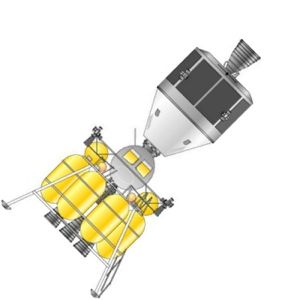 | CEV CEV and NASA Lunar Lander, late 2005 Credit: © Mark Wade |
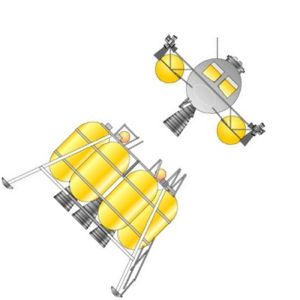 | CEV CEV and NASA Lunar Lander, late 2005 Credit: © Mark Wade |
 | CEV Comparison of larger manned re-entry capsules, from left: CEV; Apollo CSM; Big Gemini; TKS; Soyuz; Shenzhou Credit: © Mark Wade |
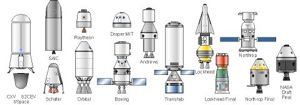 | CEV CEV's Compared Credit: © Mark Wade |
 | CEV CEV Command Modules compares Credit: © Mark Wade |
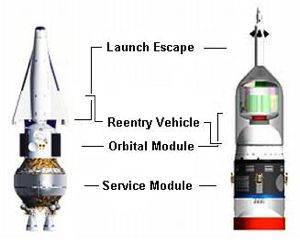 | CEV Comparison of Lockheed and Northrop CEV proposals. |
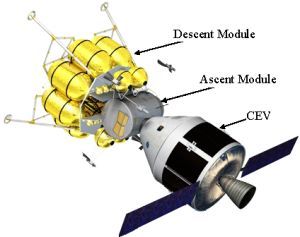 | CEV CEV and Lander Credit: NASA |
 | OSP Winged Winged variant of NASA's planned 'Orbital Space Plane'. Credit: NASA |
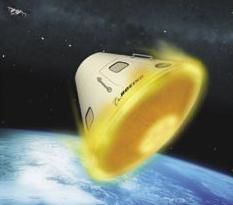 | OSP Ballistic Ballistic variant of NASA's planned 'Orbital Space Plane'. Credit: NASA |
- Orion EFT-1 - .
Mass: 9,400 kg (20,700 lb). Nation: USA.
Class: Manned.
Type: Manned spacecraft. Spacecraft Bus: Orion CEV.
Spacecraft: Orion.
Decay Date: 2014-12-05 . USAF Sat Cat: 40329 . COSPAR: 2014-077A. Apogee: 5,809 km (3,609 mi). Perigee: -37 km (-37 mi). Inclination: 28.80 deg.
Exploration Flight Test 1 used an Orion Crew Module (probably around 9400 kg) with an LAS launch escape tower, atop a dummy Service Module with jettisonable side panels, which in turn was fixed to the OSA (Orion-to-Stage-Adapter). This vehicle was mounted on the second stage of a Delta IV Heavy vehicle 369. Delta 369's second stage was inserted into a 185 km x 888 km x 28.8 deg orbit at 12:22 GMT, 17 minutes after launch. The stage made a second burn at 14:00, entering a -37 km x 5.807 km orbit; apogee was at 1510. At 15:28 the Orion CM separated from the stage. The Orion CM made a small RCS adjust burn at 16:02 and entered the atmosphere at 8.9 km/s at 16:18, landing at 16:29 off Baja California at 23.60 deg N x 116.46 deg W. It was recovered by the USS Anchorage.
Back to top of page
Home - Search - Browse - Alphabetic Index: 0- 1- 2- 3- 4- 5- 6- 7- 8- 9
A- B- C- D- E- F- G- H- I- J- K- L- M- N- O- P- Q- R- S- T- U- V- W- X- Y- Z
© 1997-2019 Mark Wade - Contact
© / Conditions for Use